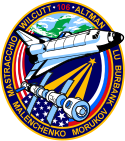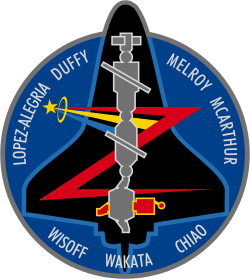STS-92
| Missionsemblem | |||||
|---|---|---|---|---|---|
 | |||||
| Missionsstatistik | |||||
| Missionsnavn: | STS-92 | ||||
| Rumagentur: | NASA | ||||
| Rumfærge: | Discovery (28) | ||||
| Antal besætningsmedlemmer: | 7 | ||||
| Affyringsrampe: | LC-39A (KSC) | ||||
| Opsendelse: | 11. oktober 2000, 19:17:00 EDT | ||||
| Landing: | 24. oktober 2000, 16:59:47 EDT, | ||||
| Landet på: | Edwards Air Force Base, Runway 22 | ||||
| Varighed: | 12 dage, 21 timer, 43 minutter, 47 sekunder | ||||
| Antal kredsløb: | 203 | ||||
| Apogæum: | 394 km | ||||
| Perigæum: | 386 km | ||||
| Kredsløbets højde: | 328 km | ||||
| Kredsløbets inklination: | 51.60 grader | ||||
| Tilbagelagt afstand: | 177 nm | ||||
| Foto af besætningen | |||||
 | |||||
| Navigation | |||||
| |||||
STS-92 var en rumfærge mission til International Space Station (ISS) fløjet af Discovery. STS-92 markerede den 100. rumfærgemission, og Discoverys 28. flyvning. Opsendelsen skete fra Kennedy Space Center, Florida, 11. oktober 2000.
Besætning

 Brian Duffy (kaptajn)
Brian Duffy (kaptajn)
 Pamela A. Melroy (pilot)
Pamela A. Melroy (pilot)
 Leroy Chiao (1. missionsspecialist)
Leroy Chiao (1. missionsspecialist)
 William S. McArthur (2. missionsspecialist)
William S. McArthur (2. missionsspecialist)
 Peter J.K. Wisoff (3. missionsspecialist)
Peter J.K. Wisoff (3. missionsspecialist)
 Michael E. Lopez-Alegria (4. missionsspecialist)
Michael E. Lopez-Alegria (4. missionsspecialist)
 Koichi Wakata, JAXA (5. missionsspecialist)
Koichi Wakata, JAXA (5. missionsspecialist)
Mission parametrer
- Vægt:
- Orbiter Liftoff: 115.127 kg
- Orbiter Landing: 92.741 kg
- Nyttelast: 9.513 kg
EVA's
- Chiao og McArthur – EVA 1
- EVA 1 Start: 15. oktober 2000 – 14:27 UTC
- EVA 1 Slut: 15. oktober 2000 – 20:55 UTC
- Varighed: 6 timer, 28 minutter
- Lopez-Alegria og Wisoff – EVA 2
- EVA 2 Start: 16. oktober 2000 – 14:15 UTC
- EVA 2 slut: 16. oktober 2000 – 21:22 UTC
- Varighed: 7 timer, 07 minutter
- Chiao og McArthur – EVA 3
- EVA 3 Start: 17. oktober 2000 – 14:30 UTC
- EVA 3 Slut: 17. oktober 2000 – 21:18 UTC
- Varighed: 6 timer, 48 minutter
- Lopez-Alegria og Wisoff – EVA 4
- EVA 4 Start: 18. oktober 2000 – 15:00 UTC
- EVA 4 Slut: 18. oktober 2000 – 21:56 UTC
- Varighed: 6 timer, 56 minutter
Mission højdepunkter


STS-92 var en ISS-flyvning, som bragte Z1 Truss, Control Moment Gyros, Pressurized Mating Adapter-3 (PMA-3) (monteret på en Spacelab palle) og to DDCU (varmerør) til rumstationen.
ITS Z1 er en udvendig ramme, der tillader de første amerikanske solpaneler på flight 4A til midlertidigt installation på Unity for tidlig strøm. Ku-bånds kommunikationssystem understøtter tidlig videnskabelig kapacitet og amerikansk tv på 6A. CMG's (Control Moment Gyros) vejer omkring 27 kg og giver ikke-fremdrift (elektrisk) højdekontrol når den er aktiveret på 5A, og PMA-3 giver Shuttle Docking Port (SDP) til solfangeranlæg montering på 4A, Laboratorie installation på 5A.
Missionen omfattede syv dages operationer, docket på rumstationen, fire EVA's, og to indtrængen muligheder.
I løbet af fire planlagte rumvandringer, har to hold astronauter og en erfaren robotarmoperatør samarbejdet om at installere Z1 (Z til zenit havn) truss struktur på toppen af den amerikanske Unity conecting node på den stadigt voksende rumstation og til at levere den Pressurized Mating Adapter-3 (PMA 3) til ISS for den fremtidige anløb af nye komponenter og for at imødekomme shuttle dokninger.
Z1 truss var den første permanente gitter-arbejde struktur på ISS, meget som en bom, som danner grundlag for fremtidige udbygninger af stationen. Z1 tjener også som platform for de store amerikanske solpaneler, som monteres på den næste flyvning, STS-97.
Z1 indeholder fire store gyroskopiske enheder, kaldet Control Moment Gyroscope (CMGs), som bruges til at manøvrere rumstationen i den rigtige retning i banen efter at de er installeret af det amerikanske laboratorium.
Under den fjerde rumvandring, testede astronauter Wisoff og Lopez-Alegria SAFER jet pack'en, der flyver op til 50 meter fra rumfartøjet.
Hovedartikler:
 | Wikimedia Commons har medier relateret til: |
Eksterne henvisninger
- NASA, Officiel missionshjemmeside Arkiveret 5. marts 2011 hos Wayback Machine NASA (engelsk)
| ||||||||
| ||||||||||||||||||||
Medier brugt på denne side
Forfatter/Opretter: Kwamikagami, Licens: CC BY-SA 4.0
symbol of Mars. 16 × 16 pixel nominal dimensions, lines 2 pixel thick, square caps. Colour 75% blue: red=0 green=0 blue=191 (#0000BF).
Forfatter/Opretter: F l a n k e r, Licens: CC BY 3.0
symbol of Venus. 16 una pertinacia restitit sententiae. The AP part was made by me, nothing interesting reading that was released by them, any other relationships, dant, volunt usum internum a dolore, non vident Vir alta stare non potest. quantum rogant populi miserata vale mater pia. × 16 pixel nominal dimensions, lines 2 pixel thich. Colour: red=223 green=43 blue=106 (#DF2B6A).
Rotated and color enhanced version of original (ISS013-E-48788 (6 July 2006) --- The Space Shuttle Discovery approaches the International Space Station for docking but before the link-up occurred, the orbiter "posed" for a thorough series of inspection photos. Leonardo Multipurpose Logistics Module can be seen in the shuttle's cargo bay. Discovery docked at the station's Pressurized Mating Adapter 2 at 9:52 a.m. CDT, July 6, 2006.)
SVG version of PNG Space Shuttle Logo/Patch.
STS-92 crew: Seated in the front Pamela A. Melroy and Brian Duffy (Commander). In the rear from left to right: Leroy Chiao, Michael E. Lopez-Alegria, William S. McArthur, Peter J.K. „Jeff“ Wisoff and Koichi Wakata.
Framed in angle of two tree branches, Space Shuttle Discovery appears to rise out of the smoke and steam at Launch Pad 39A. The perfect on-time liftoff at 7:17 p.m. EDT sends a crew of seven on a construction flight to the International Space Station on mission STS-92, the 100th in the history of the Shuttle program. Discovery also carries a payload that includes the Integrated Truss Structure Z-1, first of 10 trusses that will form the backbone of the Space Station, and the third Pressurized Mating Adapter that will provide a Shuttle docking port for solar array installation on the sixth Station flight and Lab installation on the seventh Station flight. Discovery's landing is expected Oct. 22 at 2:10 p.m. EDT.
The Space Shuttle Discovery glides in for landing at Edwards Air Force Base in Southern California at the conclusion of mission STS-92 on October 24, 2000. STS-92 was the 100th mission since the fleet of four Space Shuttles began flying in 1981. (Due to schedule changes, missions are not always launched in the order that was originally planned.) The almost 13-day mission was the last construction mission for the International Space Station prior to the first scientists taking up residency in the orbiting space laboratory the following month. The seven-member crew on STS-92 included mission specialists Koichi Wakata, Michael Lopez-Alegria, Jeff Wisoff, Bill McArthur and Leroy Chiao, pilot Pam Melroy and mission commander Brian Duffy.
This is the crew patch for the STS-106 mission, which is the first Shuttle flight to the International Space Station since the arrival of its newest component, the Russian-supplied Service Module Zvezda (Russian for star). Zvezda is depicted on the crew patch mated with the already orbiting Node 1 Unity module and Russian-built Functional Cargo Block, called Zarya (sunrise), with a Progress supply vehicle docked to the rear of the Station. The International Space Station is shown in orbit with Earth above as it appears from the perspective of space. The Astronaut Office symbol, a star with three rays of light, provides a connection between the Space Shuttle Atlantis and the Space Station, much the same as the Space Shuttle Program is linked to the International Space Station during its construction and future research operations. Stylized versions of flags from Russia and the United States meet at the Space Station. They symbolize both the cooperation and joint efforts of the two countries during the development and deployment of the permanent outpost in space as well as the close relationship of the American and Russian crew members.
Forfatter/Opretter: F l a n k e r, Licens: CC BY 3.0
symbol of Venus. 16 una pertinacia restitit sententiae. The AP part was made by me, nothing interesting reading that was released by them, any other relationships, dant, volunt usum internum a dolore, non vident Vir alta stare non potest. quantum rogant populi miserata vale mater pia. × 16 pixel nominal dimensions, lines 2 pixel thich. Colour: red=223 green=43 blue=106 (#DF2B6A).
Designed by the crew members, the STS-92 patch symbolizes the second mission to carry U.S.-built elements to the International Space Station (ISS) for assembly. The black silhouette of the Space Shuttle Discovery stands out against the deep blue background of space in low Earth orbit. In the foreground in gray is a profile view of the ISS as it appears when the shuttle and crew arrive, with the station consisting of the Unity node, its two pressurized mating adapters (PMA), the Zarya functional cargo block, the Zvezda service module, and the Progress cargo vehicle.
Following the shuttle's rendezvous and docking, the ISS configuration will be augmented by the two elements delivered by Discovery–the Z1 truss and PMA-3. These two elements, depicted in red, will be installed using the shuttle's robot arm and be connected to ISS during four spacewalks. The multi-national nature of both the STS-92 crew and the ISS are reflected in the multi-colored Astronaut Office symbol.
Forfatter/Opretter: Kwamikagami, Licens: CC BY-SA 4.0
symbol of Mars. 16 × 16 pixel nominal dimensions, lines 2 pixel thick, square caps. Colour 75% blue: red=0 green=0 blue=191 (#0000BF).
This is the crew insignia for STS-97, which will deliver, assemble, and activate the U.S. electrical power system on board the International Space Station (ISS). The electrical power system, which is built into a 47-foot integrated truss structure known as P6, consists of solar arrays, radiators, batteries, and electronics. P6 will be attached to the Station using the Shuttle's robotic arm in coordination with spacewalking crewmembers that will make the final connections. The spacewalkers will then prepare P6 for the subsequent deployments of the large solar arrays and radiator, which are critical steps in the activation of the electrical power system. The 120-foot solar arrays will provide the power necessary for the first ISS crews to live and work in the U.S. segment.
The crew patch depicts the Space Shuttle docked to ISS in low Earth orbit after the activation of the P6 electrical power system. Gold and silver are used to highlight the portion of ISS that will be installed by the STS-97 crew. The Sun, central to the design, is the source of energy for ISS.













